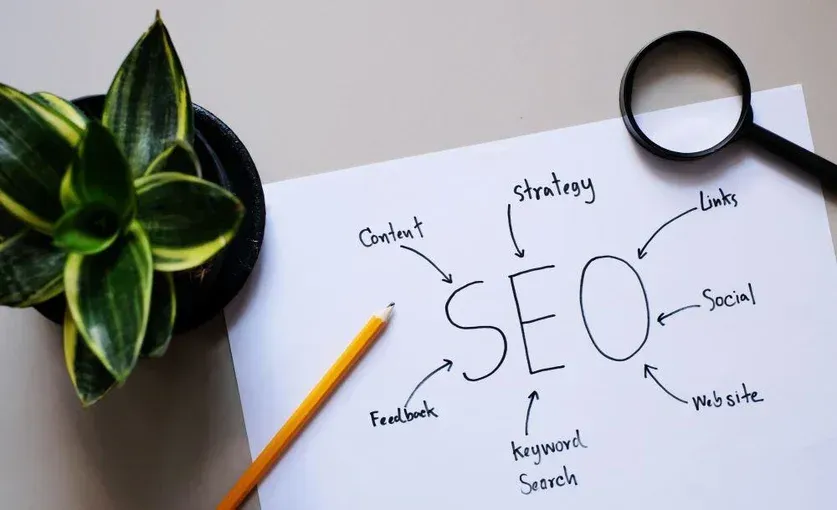- HOME
- ABOUT US
- SERVICES
- CUSTOMER STORIES
- OUR EXPERTS
- CONTACT US
- BLOG
In need of some sound digital marketing advice?
Book a free consultation with one of our experts.

Making a difference in our clients’ lives
We positively impact the lives of our clients beyond their KPI reports.
Blog Layout
Every business, regardless of size, needs a strong online presence in today's digital world. This presence builds credibility and trust and helps you reach your target audience. An effective search engine optimization (SEO) strategy can boost your online presence and supercharge growth.
When done correctly, SEO can drive qualified traffic to your website. With a winning SEO strategy, you can convert website visitors into buyers and buyers into brand advocates, taking your business to the next level.
Here are the steps to building an effective SEO strategy.
Define Your Goals
Some common SEO goals include driving more organic traffic to your website and improving website conversion rate and engagement. When setting SEO goals, ensure they align with your overall business goals and are specific, measurable, achievable, relevant, and time-bound (SMART). After you have set your SEO goals, select and define the key performance indicators (KPIs) that will help you measure SEO success.
Some SEO KPIs businesses track to measure SEO success include organic traffic from searches, pages per session, leads and conversion, and keyword rankings. These are internal SEO KPIs that you can track using analytics.
Perform a Comprehensive SEO Audit
Once you have defined and set your SEO goals, it's time to perform an SEO audit to understand where you currently stand. A comprehensive SEO audit can help you identify problems that could negatively impact your SEO rankings.
Assess the quality of your website content and backlink profile. Check the website architecture and sitemap and ensure that robots.txt files are set up correctly. Implement changes to site structure if necessary to ensure that search engines can crawl your website and visitors can easily find the information they’re looking for.
Perform Keyword Research
Keyword use is a Google ranking factor. Keywords tell Google what your content is about. You cannot stuff your content with random keywords and must look for relevant, high-volume, low-competition keywords. When performing keyword research using keyword research tools, try to understand the user intent behind search queries and choose keywords that can help you attract your target audience rather than people searching for something else.
Look for low-competition keywords with high search volumes. Focus on long-tail conversational keywords to effectively target individuals in a specific conversion funnel stage.
Conduct a Competitive Analysis
A competitive analysis can help you assess your competitor’s strengths and weaknesses. Find out which keywords your competitor is ranking for. Check their backlink profile and site structure to identify website optimization opportunities. Use tools like SpyFu and SimilarWeb to analyze the competition's content strategy. Remember, AI chatbots are your website’s competitors, too. To compete with AI chatbots, build brand authority, and create engaging content.
Create and Implement a Content Strategy
A winning content strategy can help build authority and engage your target audience effectively. Before creating a content strategy, define your goals. Do you want to improve brand awareness? Want to demonstrate thought leadership? By clearly defining your strategy, you can identify the right type of content to unlock success.
Create customer profiles based on demographics and your audience’s tastes and preferences. Audit existing content to understand what works and what doesn’t. Consider updating or tweaking old content according to industry trends to keep it relevant. Develop a content calendar, outline topics, set deadlines, and create a realistic publishing schedule.
Write engaging content that answers readers’ questions and addresses their pain points. Naturally incorporate relevant keywords into your content. Optimize headlines, meta descriptions, and content structure to increase the likelihood of your page appearing in search results.
Build and Implement a Link Building Strategy
Quality backlinks can boost your domain authority and improve rankings. To attract authority backlinks, create well-researched and engaging content. Use images, illustrations, and graphics to create easy-to-share visual content.
Write emails to website owners asking for backlinks (instead of using generic templates, craft tailored messages highlighting mutual benefits). Offer to write quality content or testimonials and case studies in exchange for backlinks.
Share your content on social networking sites to improve its visibility. Contact website owners and suggest that they use your content to replace broken links on their sites. Take steps to improve page speed and make your site more user-friendly.
How to Leverage AI to Improve SEO?
AI is transforming SEO by automating time-consuming and tedious tasks, allowing SEO managers to focus on their key result areas (KRAs).
Here are some tasks that can be automated using AI.
- Keyword Research: AI can analyze large data sets to identify trends and relevant keywords. ChatGPT and other AI tools can be used to identify keywords and research ideas.
- Content Optimization: NLP models can evaluate the readability of your content and semantic relevance. AI tools can recommend content changes that you can follow to align your content with search intent.
- Competitor Analysis: AI can analyze your competitor’s backlink profile and keyword rankings quickly and effectively.
- Voice Search and Local SEO: AI tools can be used to write content tailored for voice search patterns. You can perform a local SEO strategy gap analysis with Google's AI tools.
- Technical SEO Audit: AI tools can automate technical SEO audits, helping SEO professionals quickly identify problems such as broken links and improper indexing. AI tools generate detailed diagnostic reports and recommendations, helping SEO experts develop action plans to improve SEO.
- Predictive Analytics: AI can forecast trends and identify search patterns, helping content managers assess their strategies. With AI, SEO managers can use historical data to predict future search trends. Content managers can plan content calendars based on seasonal trends.
- Link Building: SEO managers can use AI to identify link-building opportunities and evaluate existing links. Thanks to AI, it has become easier for them to identify authoritative domains that can be used for link-building campaigns.
Building a successful SEO strategy is a multi-faceted process that requires careful planning, continuous analysis, and consistent effort. By defining clear goals, conducting thorough audits, researching relevant keywords, and implementing a robust content and link-building strategy, you can position your website for sustained growth.
Leveraging AI tools can further optimize your efforts, enhancing efficiency and enabling you to stay ahead in the ever-evolving SEO landscape. Remember, SEO is not a one-time task—it’s a long-term commitment to creating value for your audience and achieving measurable business results. Start today and watch your online presence grow.
The Best Digital Marketing Insight and Advice
The WSI Digital Marketing Blog is your go-to-place to get tips, tricks and best practices on all things digital marketing related. Check out our latest posts.
Subscribe Blog
Thank you for contacting us.
We will get back to you as soon as possible.
We will get back to you as soon as possible.
Oops, there was an error sending your message.
Please try again later.
Please try again later.
*You may unsubscribe from digital communications at anytime using the link provided in WSI emails.
For information on our privacy practices and commitment to protecting your privacy, check out our Privacy Policy and Cookie Policy.
For information on our privacy practices and commitment to protecting your privacy, check out our Privacy Policy and Cookie Policy.
Don't stop the learning now!
Here are some other blog posts you may be interested in.

By WSI Team
•
April 25, 2025
Forming a bond with your audience on social media is no longer just an alternative digital marketing strategy—it's necessary for any business that wants to prosper. Social media engagement strategies help businesses cultivate relationships, interact with customers, and establish meaningful connections. Social media networks provide an exclusive space to build this connection and enhance brand loyalty. A good social media strategy can build trust and loyalty, enhance a brand's visibility, increase website visits, and ultimately increase sales. By understanding customers' journeys and practicing effective engagement strategies, businesses can maximize their presence on social media platforms and develop a loyal online community. Mastering the social media customer journey allows brands to connect with users at every stage, from awareness to purchase, making the process smoother or more successful. Importance of Social Media Engagement Interacting with your followers on social media provides numerous advantages. It's about creating authentic relationships that extend beyond sales. Here is why engagement should be a fundamental part of your social media approach: Encourages Customer Faithfulness: If the customers sense they are heard and appreciated, they often stay loyal to your brand. Interaction establishes a mutual conversation that enhances the connection between your business and its audience. Boosts Recognition of Brand: Refers to actions such as liking, sharing, and commenting, which can naturally broaden your scope. When people engage with what you post, their responses amplify your presence and introduce your brand to potential new clients. Boosting brand visibility on social media is essential for reaching a broader audience and establishing a robust brand identity. Gives Useful Insights: Social media acts as a direct connection to your consumers. By paying attention and engaging, you learn what they like, their issues, and their wishes. This helps you improve your goods and services. Boosts Brand Character: Social media allows you to show your brand's humanity. Telling stories, replying to remarks, and making personal connections make your brand seem friendlier and more approachable. Social Media Best Practices for Businesses Are you ready to increase your engagement on social media? Here are ten crucial suggestions for connecting with your audience and fully exploiting your social platforms' capabilities. Know Your Audience: To be successful in any social media strategy, it is crucial to understand your audience. You need to know who your followers are, what matters to them, and where they spend their time on the internet for genuine engagement. Demographics: Gather basic demographic information such as age, gender, location, and interests. Psychographics: Explore more about their behaviors, values, and drives. What do they like? What types of social media content connect with them? People: Create comprehensive person profiles to symbolize your perfect audience group. These profiles will assist in steering the creation of content and confirm that you're addressing your audience's needs and wants directly. Stay Active and Consistent: Consistency is critical when using social media. If you post content regularly, your brand will always be remembered, and it will also help to support engagement. Make a Content Schedule: Arrange your social media posts beforehand with diverse materials, such as educational, amusing, and marketing pieces. A content schedule assists in keeping you on track and delivers consistent article posting. Use Planning Tools: Employ social network management tools such as Hootsuite or PromoRepublic to schedule posts beforehand and maintain a regular presence across different social media channels. Respond Promptly: Answering promptly demonstrates that you appreciate your audience's feedback and are deeply involved with your community. Whether it's a comment, inquiry, or complaint, an immediate response can significantly impact how your brand is perceived online. Show gratitude for praise and good communication: This strengthens customer bonds and creates a good reputation. Tackle Unfavorable Criticism in a Professional Manner: Respond to adverse comments with understanding and professionalism. Use them as an opportunity to show your dedication to customer satisfaction. Incorporate Visuals: Visual content is significant for attracting attention on social media. Posts that include pictures or videos generally get more interaction than posts that only contain text. Use Superior Quality Pictures: Invest in excellent photography and creative design. High-standard pictures and films show professionalism and are more likely to attract attention. Try Different Styles: Change your content by including pictures, videos, infographics, and GIFs. This variety will maintain interest in your feed and keep it fresh. Cultivate User-Generated Content: User-generated content (UGC) is a great way to establish credibility and authenticity. It provides social evidence when your followers share their interactions with your brand. Promote Involvement: Develop activities where viewers can submit their pictures, experiences, or recommendations. Use specific hashtags related to your brand to discover and distribute this material straightforwardly. Be a Storyteller: Storytelling is powerful for forming emotional connections with your audience. Share stories related to your trademark, products, and clients. Provide Inside Information: Let your followers see what's happening behind the scenes of your business. This will make your brand more relatable and help establish a stronger bond. Present Customer Experiences: Distribute customer feedback and successful experiences demonstrating how your products or services have made a positive difference. Use Polls and Surveys: Polls and surveys are interactive tools that engage your audience while providing valuable feedback. Pose Interesting Questions: Conduct enjoyable and relevant surveys relevant to your spectators' interests. Use the outcomes to direct your content strategies. Gather Feedback: Use questionnaires to collect thoughts and advice from your supporters. This demonstrates that you appreciate their participation and are open to improvements based on their feedback. Host Live Q&A Sessions: Q&A live sessions present a unique opportunity to bond with your audience instantly. They allow you to respond to queries, share knowledge, and participate in open dialogue. Advertise Your Live Events: To create excitement, let people know about your Q&A events before they happen. Distribute preview content to get people curious about what is to come. Leverage Analytics to Adapt: Reviewing your social media performance is crucial for improving your strategy. Use analytics tools to monitor significant numbers and understand what's practical. Watch Engagement Metrics: Follow likes, comments, shares, and click-through rates to understand how your content connects with your viewers. Change Your Plan: Use the data to spot patterns and make informed changes. If a particular kind of content shows good results, consider integrating more of it into your plan. Experiment and Innovate: Trends in social media change rapidly, and strategies that were successful yesterday may be ineffective tomorrow. Maintain flexibility and display a readiness to adopt new methods. Measuring the Success of Your Social Media Engagement Efforts To understand how well your social media campaigns are working, focus on the main progress signals (KPIs) that align with what you want to achieve, such as: Engagement Rate: This is the proportion of interactions (likes, comments, shares) to followers or impressions. It represents the extent to which the audience participates in your content. Click-Through Rate (CTR): This is the percentage of individuals clicking on a link in your article. It shows your content's attractiveness and capability to attract more visitors. Conversion Rate: This refers to the portion of users who perform a specific action, like registering or buying something, after interacting with your content. Follower Growth: If your followers are increasing, your post is being well-received and bringing in new followers. Are you ready to enhance your social media engagement in 2025 and beyond? WSI is here to provide advice from digital marketing experts and customized social media engagement strategies to assist you in connecting, growing, and being successful across social media. Contact us, and let's join forces to boost the sound of your brand and create an active community online.

By WSI Team
•
April 25, 2025
Why is proper LinkedIn etiquette essential for succeeding on this platform? LinkedIn is the world’s largest professional network, so it’s easy to understand why it’s such a force to be reckoned with in the digital marketing world. With a user base projected to reach nearly 1 billion by 2028 and ranked the #1 most trusted platform by brands, LinkedIn offers unparalleled opportunities for businesses to connect with potential clients, partners, and employees. However, to succeed on LinkedIn, you need to understand the nuances of platform etiquette. Read on for your guide to mastering LinkedIn. Content is King (But Context is Queen) Share insightful content relevant to your industry. Think thought-provoking articles, industry news, and actionable tips. Avoid blatant self-promotion and position yourself as a thought leader and resource. You should also: Tailor Your Message: As with all digital marketing, the best place to start is to consider your audience and tailor your content accordingly. What are their interests and challenges? How can you provide value to their professional lives? This is crucial for building meaningful professional relationships and growing your network. Engage, Don’t Just Broadcast: Most LinkedIn strategies focus purely on posting... but what happens after that? Responding thoughtfully to comments, participating in discussions, and building diverse LinkedIn connections are just as important. Over 70% of marketers see LinkedIn as a platform with solid ROI potential—but you’ll only reach that potential through engagement, not passive posting. Remember, maintaining a positive professional image on LinkedIn is essential. LinkedIn Post Frequency and Timing Matter It’s important to share content regularly to maintain visibility and boost brand awareness, but remember that it’s better to post less frequently with high-value content than to inundate your audience with irrelevant posts. Strategic timing is also crucial—consider when your target audience is most active on LinkedIn and experiment with different posting times to determine what yields the best engagement. Tools like LinkedIn analytics can provide valuable insights into audience activity. This can help increase the reach of your post and keep your content at the forefront of your mind with your new connections. Build a Compelling Company Page Your company page is often the first impression potential clients and partners have of your business. Make it count with a professional logo and a visually appealing cover image that reflects your brand identity. Here are a few other tips for building a LinkedIn company page: Evocative Company Description: Go beyond a dry recitation of your services. Write a compelling company description articulating your value proposition, target audience, and unique selling points. Demonstrate Your Expertise: Use your company page to highlight your industry expertise, showcase client success stories, and share valuable content relevant to your target audience. Position your business as a thought leader and go-to resource in your field. Engage Respectfully Maintain a professional tone in all your interactions. Avoid slang, jargon, and overly casual language. You’ll also see better results if you personalize your connection requests. Explain why you’re reaching out and how connecting would be mutually beneficial. Avoid sending generic requests at all costs! Following these guidelines shows respect for others' time and helps you nurture relationships effectively. When sending messages, focus on providing value. Don't respond to every message with an immediate sales pitch. Instead, build rapport and establish a connection before pitching your services. Leverage LinkedIn’s Features LinkedIn has many features that enhance its value as a professional networking platform. Here are a few worth exploring: LinkedIn Groups: Join relevant groups to expand your network and participate in industry discussions. LinkedIn Articles: Publish long-form content to establish thought leadership. Articles can also be a powerful tool for driving traffic to your website and generating leads. LinkedIn Live: Use live video to engage with your audience in real-time. Host Q&A sessions, share behind-the-scenes insights, and build a stronger connection with your followers. Visuals Enhance Engagement Try to incorporate visuals into your posts to grab attention and increase engagement. Most importantly, use high-quality images and videos relevant to your content. Infographics and data visualizations are especially effective. These tools present complex information in an easy-to-understand format, which can be very useful for engaging audiences. LinkedIn Hashtags Expand Reach Use relevant hashtags to increase the visibility of your posts. Research popular hashtags in your industry and incorporate them strategically – but be strategic about it. While hashtags are beneficial, avoid using too many. Focus on a few highly relevant hashtags (up to five) rather than a long list of generic ones. Don't Post Anything That Might Hurt Your Professional Image Avoid posting unprofessional, controversial, or irrelevant content to your network. Always keep business etiquette in mind when making connections. The content you share on LinkedIn contributes to your online professional reputation, so it’s essential to maintain a high standard of professionalism. Here are some things to avoid: Personal Drama or Controversial Topics: Keep personal opinions, especially on sensitive topics, to a minimum. LinkedIn is a professional platform, so focus on discussions that align with your industry and business interests. Sharing polarizing or inappropriate content may damage your credibility and alienate potential connections. Negative Comments or Complaints: Whether about your current employer, a client, or a competitor, airing grievances on LinkedIn reflects poorly on your professionalism. Instead, focus on solutions and constructive discussions that showcase your expertise and problem-solving skills. Overly Casual or Irrelevant Posts: While it’s great to show personality, LinkedIn is not the place for casual memes, jokes, or posts unrelated to your professional life. Remember, the goal is to foster real relationships and connect with new clients or business partners , not to gain popularity through viral content. Always think about how your post might reflect on your brand before sharing. Self-Promotion or Sales Pitches: Although LinkedIn is a platform for building relationships and growing your network, avoid using it as an overt sales channel. Posting content that is too promotional or focused on selling can come across as pushy and insincere. Always provide value and context before mentioning products or services. Ways to Maintain Professionalism on LinkedIn When connecting with others on LinkedIn, it's important to uphold professionalism. Here are some do's and don’ts to guide your behavior: Do's: Share relevant, insightful content related to your industry. Your profile must have A professional headshot, as it helps establish credibility. Regularly navigate LinkedIn to engage with new and existing connections. This will help expand your professional network, especially if you add people relevant to your industry or job opportunities. Don’ts: Avoid spamming connection requests. Instead, send a polite connection message when you want to connect with someone new. Always show respect for others, especially when initiating conversations. Don't use automation tools to send generic messages or requests, as it could harm your relationship-building efforts. LinkedIn Inbox : If someone views your profile or a new LinkedIn connection sends you a message, respond in a timely manner. Connecting with the right people is essential, but maintaining that connection is just as crucial for your professional growth. Other Best Practices Connect with people who share common professional interests, even if you're not interested in immediate business opportunities. LinkedIn is a professional social network, and relationship-building should be at the core of your efforts. Consider exploring topics that LinkedIn recommends to spark meaningful conversations. Be mindful of your privacy policy settings to control who sees your posts and interactions, protecting both your personal and professional reputation. Update your choices regularly to ensure you're safeguarding your presence on LinkedIn. Lastly, when you use LinkedIn to tag someone in a post, ensure it’s relevant and adds value to the conversation. Tagging unnecessarily or excessively can come across as spammy and harm your reputation. As you can see, we’ve done our LinkedIn strategy-posting etiquette homework so you don’t have to. Contact your local WSI Consultant today for more LinkedIn etiquette tips and to develop a bespoke strategy that aligns with your business objectives.

By WSI Team
•
April 25, 2025
Content is a vital component of a successful digital marketing strategy. However, even the best-performing content can experience a decline in traffic, engagement, and rankings over time. This phenomenon, known as content decay, can significantly impact your search engine visibility and overall marketing effectiveness. By understanding content decay and implementing strategic updates, businesses can maintain their content's relevance, improve search rankings, and drive consistent organic traffic. Understanding Content Decay and Its Impact on Organic Traffic As search engine algorithms evolve and new content enters the digital landscape, older content can lose its ability to attract visitors and rank well. This decline in performance, or content decay , occurs when a webpage's relevance and authority diminish over time. Left unchecked, content decay can lead to decreased organic traffic, lower search rankings, and reduced engagement. As Neil Patel says, updating content actually takes less work and delivers faster results, which can only benefit your overall content marketing strategy. However, understanding why content decay happens and how it impacts your website's visibility is essential for developing an effective content refresh strategy. Why Content Decay Matters for SEO As we mentioned, content decay refers to the gradual decline in a webpage's performance over time. This decline typically manifests as lower search rankings, reduced traffic, and decreased user engagement. Several factors contribute to content decay, including outdated information, increased competition, and changes in search intent. If left unaddressed, content decay can weaken your website's authority and reduce your visibility on search engine results pages (SERPs). Search Engine Rankings Content that is not regularly updated may slip down the SERPs, making it harder for users to find. Search engines prioritise fresh, relevant content that aligns with current user queries. If competitors publish more up-to-date and comprehensive content, they may outrank older pages, leading to a drop in organic traffic. User Experience and Engagement Outdated or irrelevant content can also negatively impact the user experience. If visitors land on a page only to find information that no longer applies, they will likely leave quickly, increasing the bounce rate. For instance, if an article still discusses pandemic lockdowns in the present tense, users will question the credibility and freshness of the content, reducing trust in the website. Search Intent and Click-Through Rates (CTR) Search intent evolves over time. According to Ahrefs, search intent shifts happen because words change meaning over time, and Google needs to reflect this change—otherwise, it can't fulfill its mission to provide the best search results for its users. Content that previously aligned with user searches may no longer meet their expectations. As a result, click-through rates may decrease, reducing overall traffic to the page. Keeping content aligned with evolving search intent ensures it continues to attract and engage visitors. Algorithm Updates and Competitive Shifts Google and other search engines frequently update their algorithms to provide the most relevant results to users. According to SearchEngineLand, Google launched 4,725 changes to its search—including changes to its ranking systems, user interface, and more—in 2022. That means Google Search changed 13 times per day, on average, that year. These updates often reward high-quality, fresh content, while outdated content may lose rankings. Additionally, as competitors create new and improved content, they may push older pages further down the SERPs. Identifying Your Best-Performing Content It's also true that not all content contributes equally to your website's success. Some pages generate steady traffic, engagement, and conversions, while others struggle to gain traction. Identifying your best-performing content allows you to focus on high-impact updates, ensuring that your most valuable pages continue to drive results. By analysing key performance metrics, you can determine which content deserves a refresh and which may need a complete overhaul. Tracking Key Performance Metrics To maintain an effective content strategy, businesses must continuously evaluate their existing content and determine which pages perform well and which require updates. Not all content maintains its relevance and effectiveness indefinitely—search algorithms change, competition increases, and user behavior evolves. By tracking key performance metrics, businesses can identify content that drives traffic and engagement and spot opportunities for improvement. Organic traffic is one of the most critical metrics to monitor. It measures the number of visitors arriving at a page through search engines. A steady flow of organic traffic indicates that the content remains relevant and well-ranked. At the same time, a noticeable decline suggests that the page may need updates to maintain its position in search results. Engagement rates provide deeper insights into how users interact with a page. Metrics such as time spent on the page, scroll depth, and interactions (e.g., clicking on links or playing embedded videos) indicate whether visitors find the content valuable. If engagement rates are low, it may be a sign that the content lacks depth, is outdated, or does not effectively address user intent. Another crucial metric is the click-through rate (CTR) , which measures the percentage of users who click on a page after seeing it in search results. A high CTR suggests that the page's title and meta description are compelling and relevant to search queries. If CTR is low, businesses should consider revising their meta descriptions, optimizing title tags, or incorporating more engaging elements such as structured data (e.g., FAQ schema) to enhance visibility. Keyword rankings play a significant role in content performance. Monitoring where a page ranks for specific keywords can help businesses understand how their content compares to competitors. A gradual decline in keyword rankings may indicate that competitors are outranking the page with more up-to-date or comprehensive content. Regularly refreshing content with new information, better optimization, and improved formatting can help regain lost rankings. Another important metric to track is impressions , which measure how often a page appears in search results. Even if a page has many impressions, a low CTR might indicate that the content does not align with user intent or that its title and description are not enticing enough. Conversely, if impressions are dropping, it may suggest that search engines consider the content less relevant over time. Bounce rate is another factor to consider when assessing content effectiveness. A high bounce rate means visitors leave the page quickly without taking further action, which could indicate that the content does not meet their expectations. Businesses should evaluate whether the page provides clear and valuable information, has a strong call to action, and loads quickly to improve user experience. Finally, backlinks —the number and quality of external websites linking to the content—serve as a strong indicator of authority and credibility. High-quality backlinks from reputable sources can significantly boost a page's search rankings. In contrast, a loss of backlinks over time might signal that the content is becoming less relevant or authoritative in its industry. By regularly tracking these performance metrics, businesses can determine which pages continue to generate value and which require optimization to remain competitive in search results. Tools for Identifying Content Decay Businesses should leverage various SEO tools to monitor content performance and detect early signs of content decay. These tools provide insights into traffic trends, keyword rankings, engagement metrics, and other crucial indicators that help businesses make informed decisions about content updates and improvements. Google Analytics Google Analytics is an essential tool for tracking organic traffic trends and user engagement metrics. It allows businesses to monitor traffic fluctuations over time and compare performance across different periods. Businesses can assess how effectively their content keeps visitors engaged by analyzing session duration, pages per session, and bounce rate. Google Analytics also provides data on traffic sources, helping businesses understand whether their content attracts visitors from search engines, social media, or referral sites. Google Search Console Google Search Console is another powerful tool for tracking keyword rankings, impressions, and click-through rates. It helps businesses identify which keywords are driving traffic to specific pages and whether rankings are improving or declining. Businesses can refine their content strategy by analyzing search queries and more effectively target relevant keywords. Search Console also provides valuable insights into indexing issues, mobile usability, and technical errors affecting search visibility. Semrush and Ahrefs Semrush and Ahrefs are advanced SEO platforms that provide in-depth analysis of keyword positioning, backlink profiles, and competitor performance. These tools allow businesses to track their rankings across multiple keywords, analyze traffic trends, and compare their content performance against competitors. Ahrefs, in particular, excels at identifying lost backlinks and providing insights into which pages are gaining or losing authority. Sermush, on the other hand, offers detailed content audits and keyword research tools that help businesses identify content gaps and optimization opportunities. Clearscope Clearscope is a content optimization tool that evaluates content relevance, readability scores, and keyword coverage. By analyzing top-ranking pages for a given keyword, Clearscope provides recommendations on related terms, content length, and structure to improve search rankings. Businesses can use Clearscope to ensure their content is comprehensive, well-structured, and aligned with current search trends. Content Auditing and Proactive Optimization Regularly auditing content using these tools allows businesses to identify declining performance early and proactively optimize their pages. When signs of content decay appear—such as dropping rankings, reduced traffic, or lower engagement rates—businesses can update their content with fresh information, improved formatting, and better keyword optimization. Some effective strategies for updating existing content include: Refreshing outdated statistics and references: Keeping content current ensures accuracy and trustworthiness. Expanding content depth: Adding new sections, case studies, or expert insights can improve value and relevance. Enhancing readability and formatting: Breaking up large blocks of text, adding bullet points, and incorporating visuals improve user experience. Optimizing for new keywords: Adapting content to include emerging search terms helps maintain rankings. Internal linking improvements: Adding links to newer content and related pages helps search engines understand content relationships. By staying proactive in content monitoring and optimization, businesses can prevent content decay, maintain search visibility, and ensure their content continues to attract and engage users over time. Strategies for Updating Content to Answer More Complex Questions As search engines evolve, so do the expectations of users. Simply providing basic information is no longer enough—modern searchers expect in-depth, well-structured answers that thoroughly address their questions. Updating content to reflect current trends, emerging best practices, and more nuanced insights ensures that it remains relevant and valuable to users and search engines. This requires a strategic approach to content updates, focusing on improving accuracy, depth, and usability. Conducting a Comprehensive Content Audit A content audit is a crucial first step in identifying areas for improvement. This process involves reviewing existing content to determine whether it remains relevant, useful, and competitive. Businesses should assess whether their pages are experiencing traffic or ranking declines, as these can be indicators that the content needs updating. Beyond performance metrics, a content audit should also evaluate search intent alignment. Over time, the user intent behind certain queries may shift. For example, a search query that previously indicated informational intent (e.g., "best marketing tools") may now suggest transactional intent, with users expecting product comparisons and purchase options. Ensuring that content meets current search intent improves its chances of ranking well. Comparing existing content with top-performing competitor pages is another essential audit step. Search engines favor comprehensive and authoritative content, meaning businesses should analyze competing articles that rank higher and identify gaps in their own content. Questions to consider include: Do competitors provide more in-depth explanations or updated data? Are they incorporating additional subtopics that we have overlooked? Do they use a more engaging structure, such as interactive elements or visual aids? Businesses can develop a targeted plan to update and expand their content by identifying weaknesses and opportunities. Expanding Topic Coverage for Greater Depth Search engines increasingly prioritize comprehensive content that provides users with a one-stop solution to their queries. Updating existing content to include more nuanced explanations, detailed insights, and additional subtopics can significantly improve its performance. For instance, a blog post from 2020 about social media marketing trends may no longer be relevant due to platform changes, new algorithms, and shifting user behaviors. Instead of simply tweaking old information, businesses should expand the scope of the content by addressing the following: The latest updates from major platforms (Facebook, Instagram, TikTok, LinkedIn, etc.) How AI and automation are reshaping social media marketing New engagement strategies that reflect current user behavior Emerging trends, such as short-form video dominance and influencer partnerships Incorporating these elements transforms outdated content into an authoritative, up-to-date resource that will likely rank well and attract new readers. Providing Actionable Advice While Removing Irrelevant Details Content should inform and guide users toward practical solutions. While expanding topic coverage is essential, businesses must ensure that content remains actionable and easy to digest. Instead of overwhelming readers with unnecessary theory or overly technical explanations, content should provide clear steps that users can implement immediately. For example, in an article about SEO best practices, rather than delving deeply into the history of search engine algorithms, the focus should be on practical steps such as: Use Google Keyword Planner to identify high-traffic, relevant keywords. Analyze top-ranking competitor content to understand keyword placement and structure. Optimize on-page elements such as meta descriptions, headers, and internal links. Regularly update existing content with fresh insights and new statistics. Improve page speed and mobile-friendliness for better user experience. By structuring content with clear steps, real-world examples, and concise explanations, businesses can ensure that users quickly find the information they need, leading to higher engagement and better retention rates. At the same time, it's crucial to eliminate outdated or unnecessary details that do not contribute to solving the reader's problem. For example, an article about email marketing automation might still reference tools that are no longer in use or strategies that have been replaced. In that case, those sections should be removed or rewritten to reflect current best practices. Enhancing Content Format and Readability Even the most well-researched content can underperform if it is not structured in a reader-friendly format. Improving readability and engagement involves several key strategies: Breaking up large blocks of text into smaller paragraphs for easier scanning. Use subheadings strategically to guide readers through different sections. Incorporate bulleted lists and numbered steps to present key takeaways. Add visuals such as charts, infographics, or screenshots to illustrate complex points. For example, in an article about effective time management for entrepreneurs, rather than presenting a long, text-heavy explanation, businesses can break down advice into easy-to-follow sections with step-by-step guides, real-life examples, and visual representations of productivity frameworks. By making content more accessible and engaging, businesses increase the likelihood that users will stay longer on the page, interact with the content, and share it with others. Optimizing for Voice Search and Conversational Queries Updating content to include natural language phrases and conversational keywords as voice search grows can help it rank for voice-assisted queries. Users who type searches may enter short keywords, but those using voice assistants often phrase their searches as complete questions or conversational prompts. For example, instead of targeting a keyword like "best coffee shops NYC," businesses should consider incorporating long-tail, conversational phrases like: "Where can I find the best coffee shops in New York City?" "What are some highly rated cafés near Central Park?" "Which coffee shops in NYC have the best cold brew?" Integrating FAQ sections with direct, natural-sounding answers can improve content visibility for voice search and featured snippets, making it more likely to appear as a top result. Enhancing User Experience A well-structured page improves readability and keeps users engaged. Consider leveraging the following tactics: Add a sticky table of contents for easy navigation. Use branded graphics and high-quality images to improve visual appeal. Break up long paragraphs into smaller chunks for better readability. Use bullet points and bold key takeaways to highlight important information. Adding Trust Factors and Freshness Signals Here are a few strategies to add trust factors and freshness signals to your content: Updating Statistics, Case Studies, and Examples: One of the most effective ways to signal freshness is by updating data and statistics. Incorporating recent industry studies, surveys, and real-world case studies enhances credibility. Users trust content that reflects the latest trends and insights. Adding Authoritative Sources and Expert Quotes: Including expert opinions, references from credible sources, and interviews with industry leaders can strengthen content authority. Citing well-known research institutions, government sources, and trusted organisations enhances credibility and trustworthiness. Leveraging User Engagement Signals: Encouraging user interaction through comments, polls, and discussions can help keep content relevant. Regularly updating blog posts with user-generated content, such as testimonials or frequently asked questions, signals ongoing engagement and relevance. Republishing and Promoting Updated Content: Once content has been refreshed, businesses should actively promote it across various channels: Share updated articles on social media platforms. Include refreshed content in email newsletters. Leverage paid promotion to reintroduce the content to a broader audience. Encourage backlinks by reaching out to industry partners and influencers. Optimizing for Featured Snippets and Voice Search Optimising content for featured snippets and voice search as search behavior evolves can enhance visibility. Structuring content with direct, concise answers and using natural language improves the chances of appearing in voice search results and position-zero rankings. Content decay is inevitable, but proactive content refresh strategies can ensure sustained visibility, engagement, and SEO performance. By identifying declining content, updating it with fresh insights, and implementing trust factors, businesses can maximize the impact of their existing content and strengthen their digital marketing efforts. Regular content audits and a commitment to continuous improvement will position businesses for long-term success in an ever-changing search landscape. Need help with your content marketing and SEO? Contact WSI today.
WSI LOCAL OFFICE
Orange County, CA
Phone: 949-216-6230
Email:
info@wsidigitalmarketingexperts.com
SOCIAL
WSI Digital Marketing Experts has been recognized as one of the Top California Digital Marketing Agencies by DesignRush
ABOUT US
CONTACT US
SERVICES
CUSTOMER STORIES
OUR EXPERTS
BLOG
© 2020 WSI. All rights reserved. WSI ICE and WSI IM are registered trademarks of RAM. Privacy Policy
and Cookie Policy
Each WSI Franchise is an independently owned and operated business.





